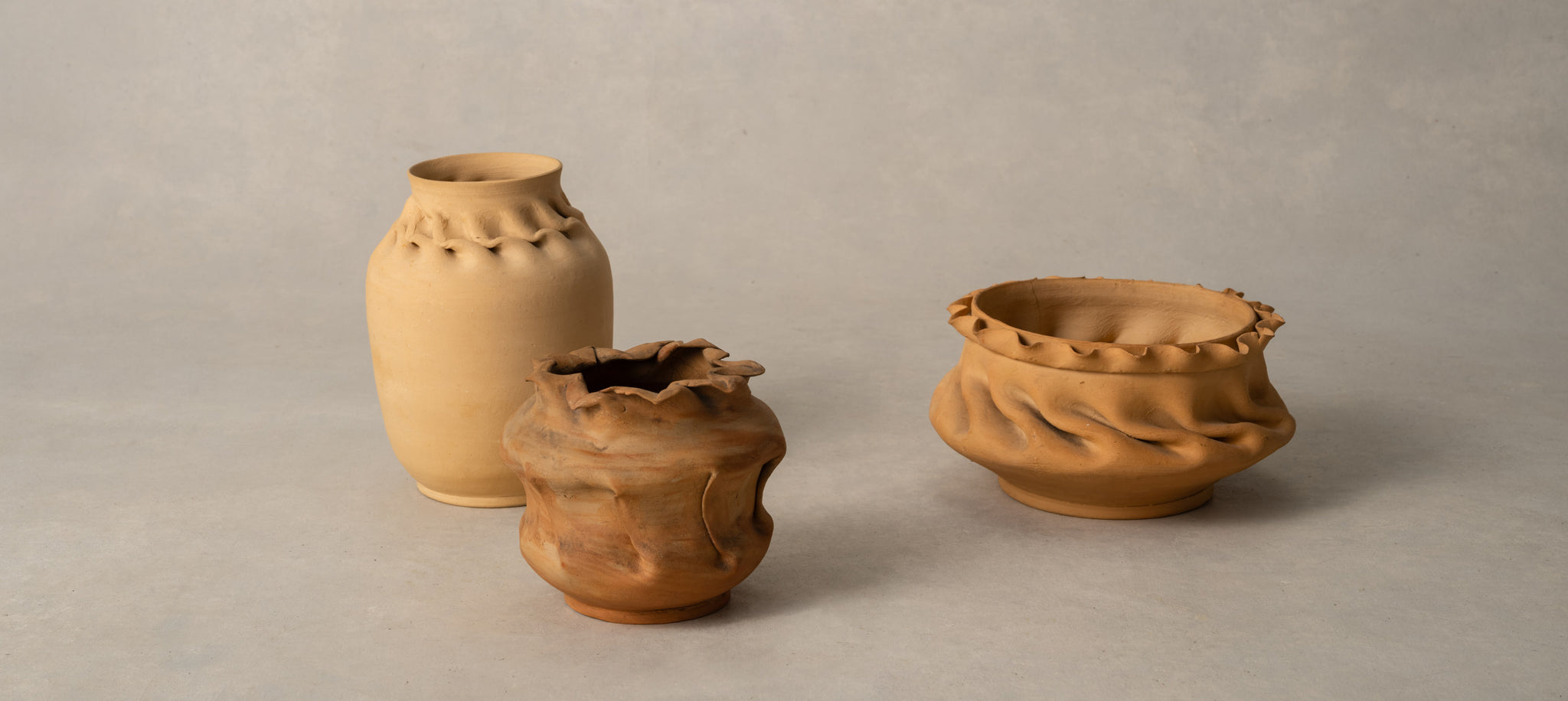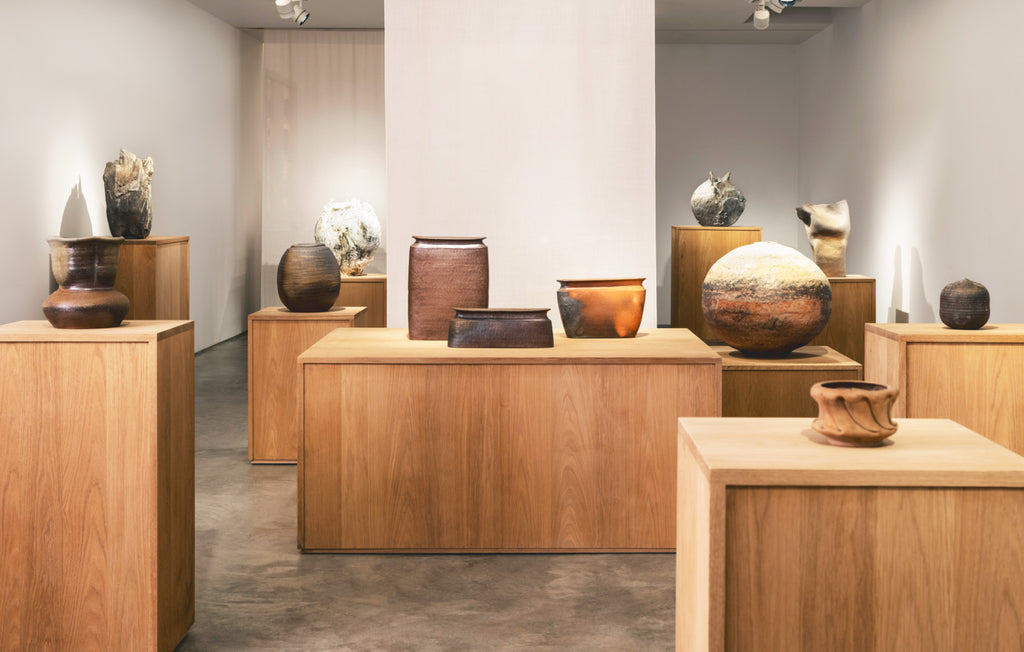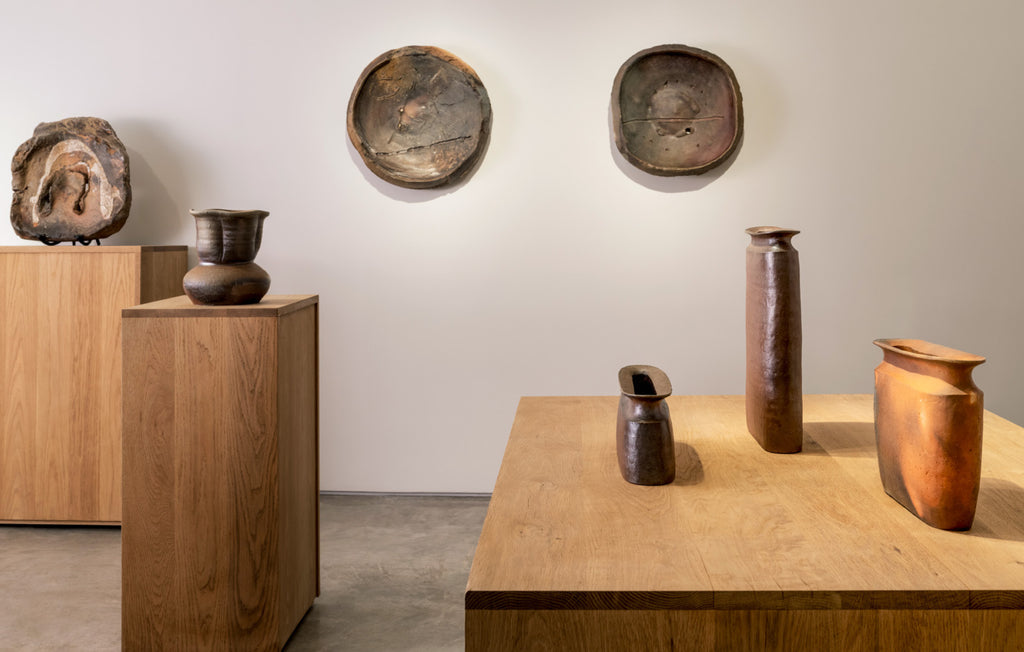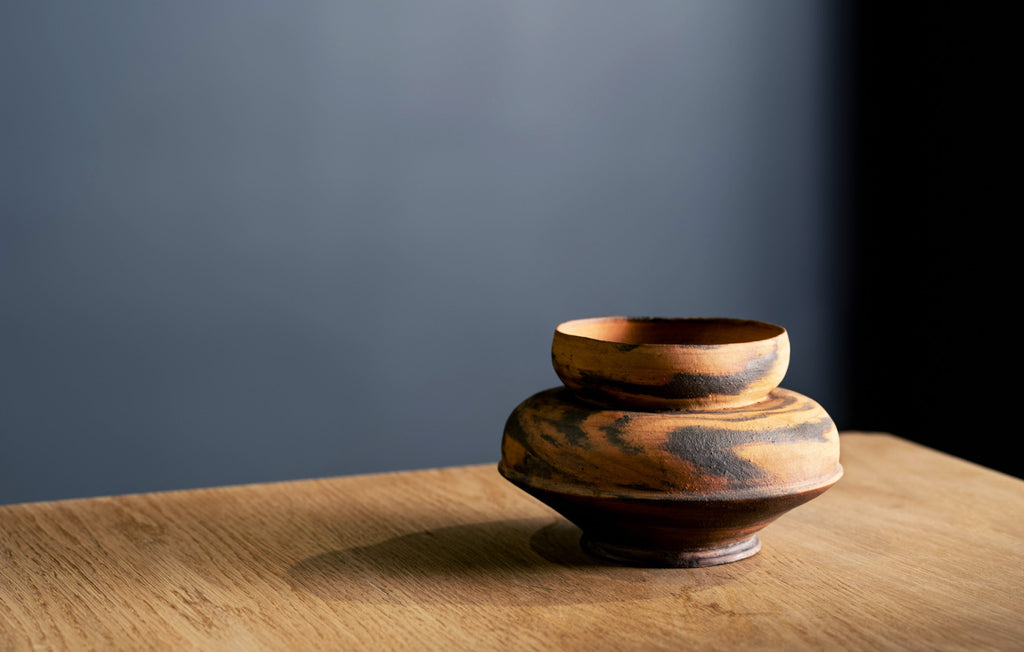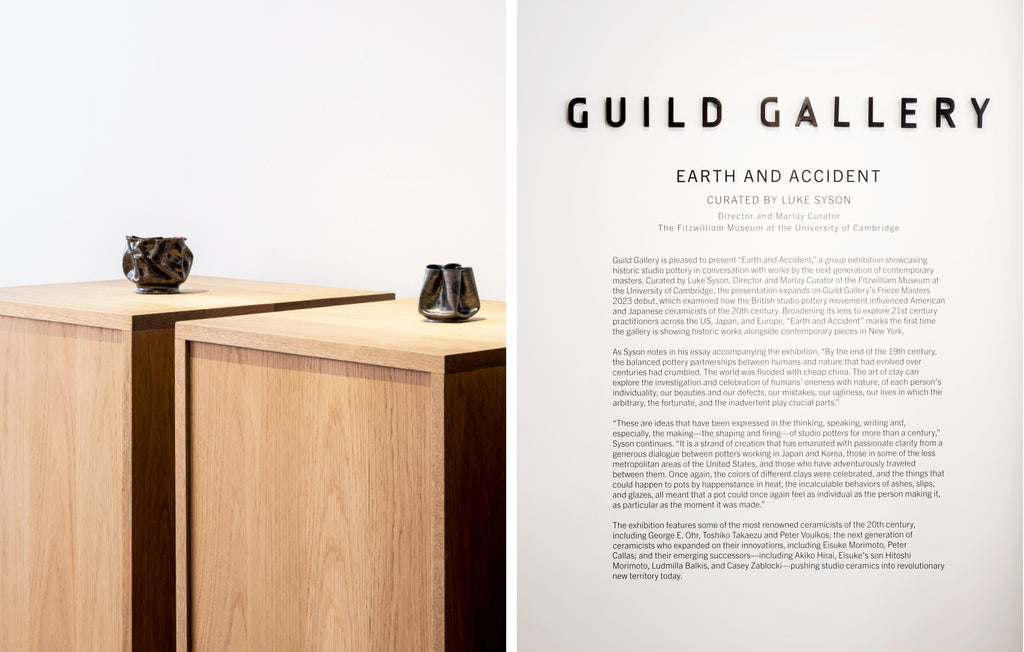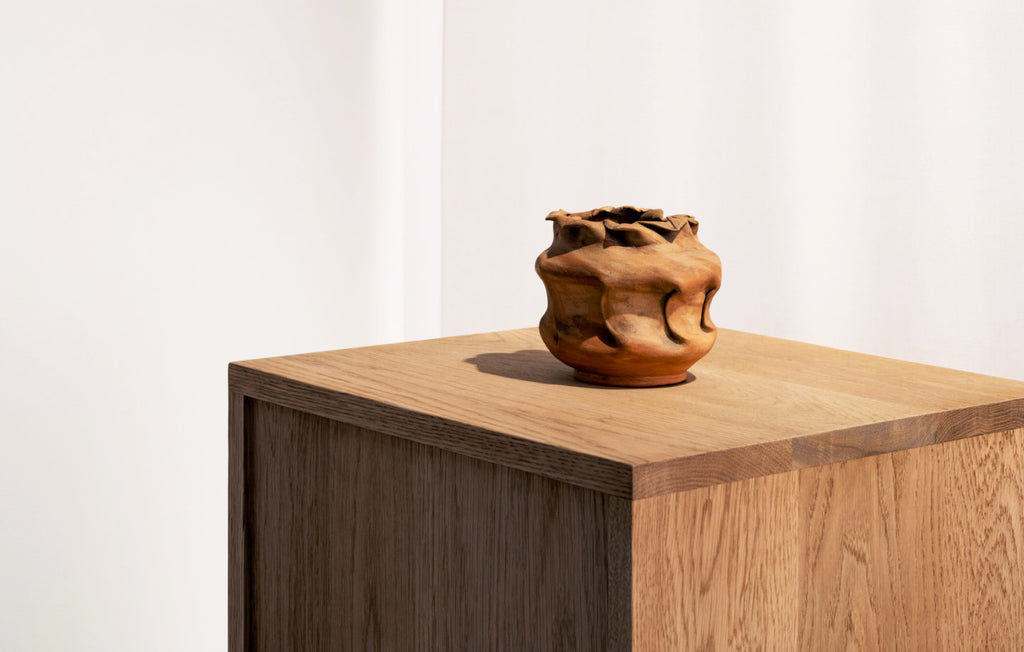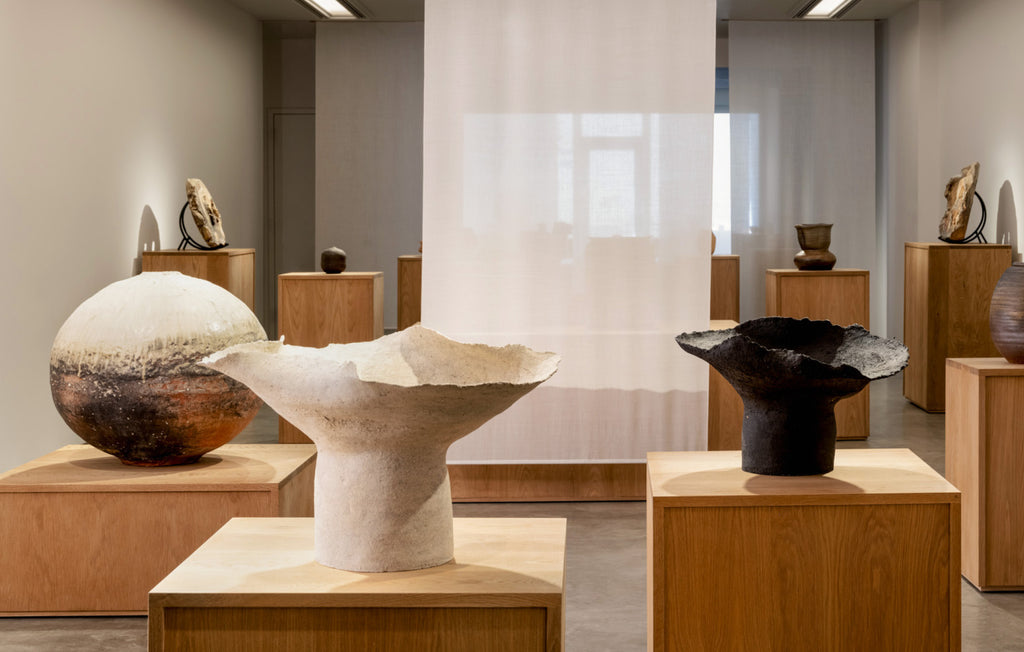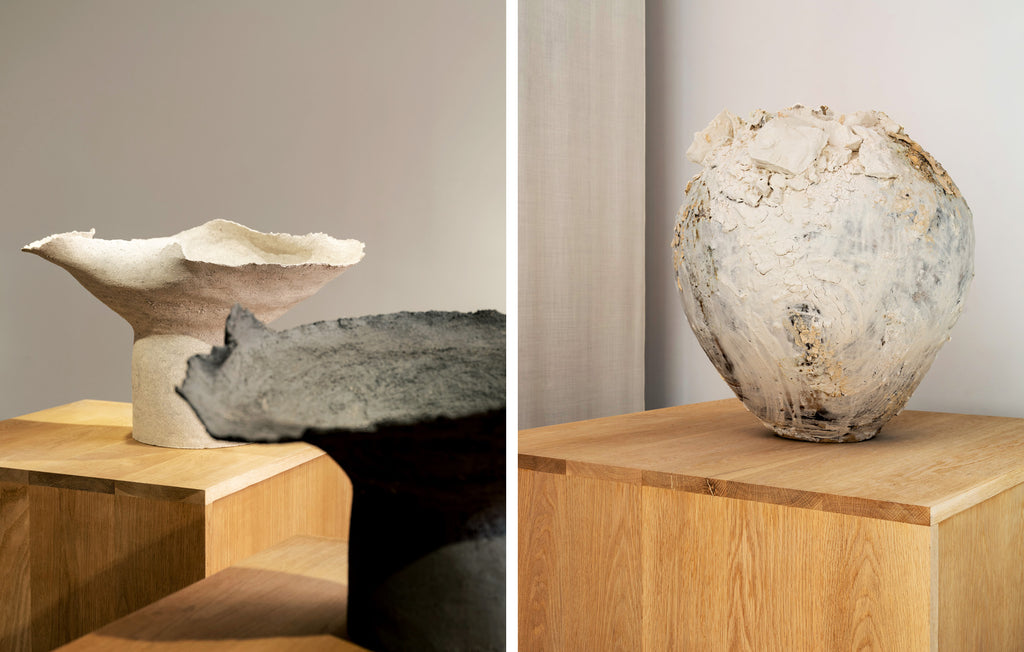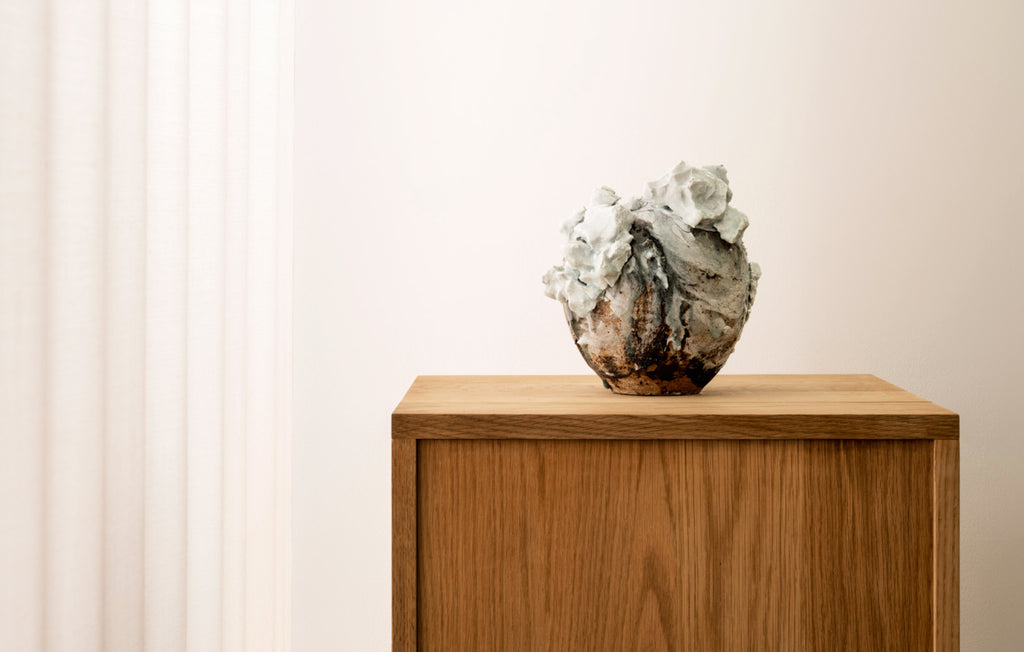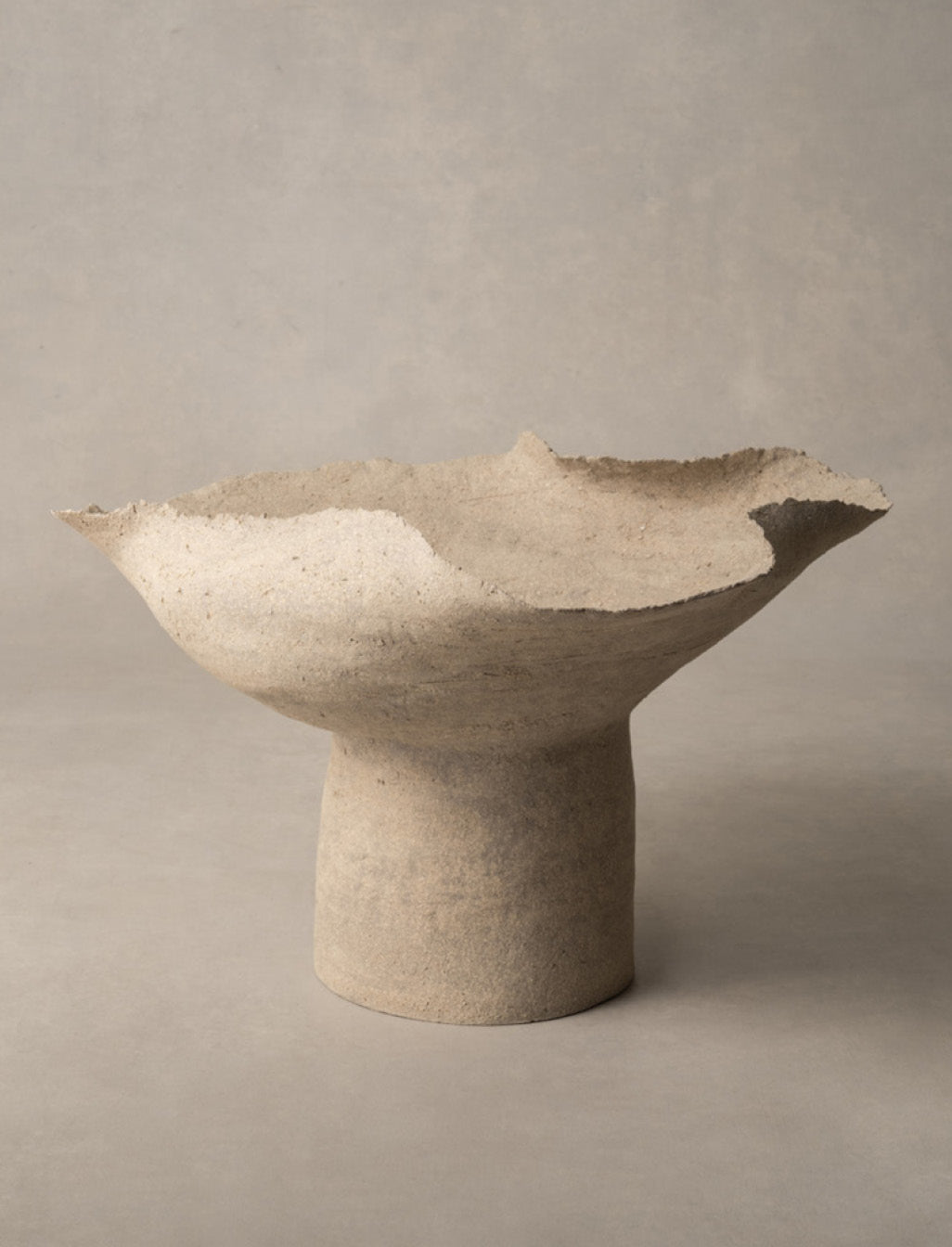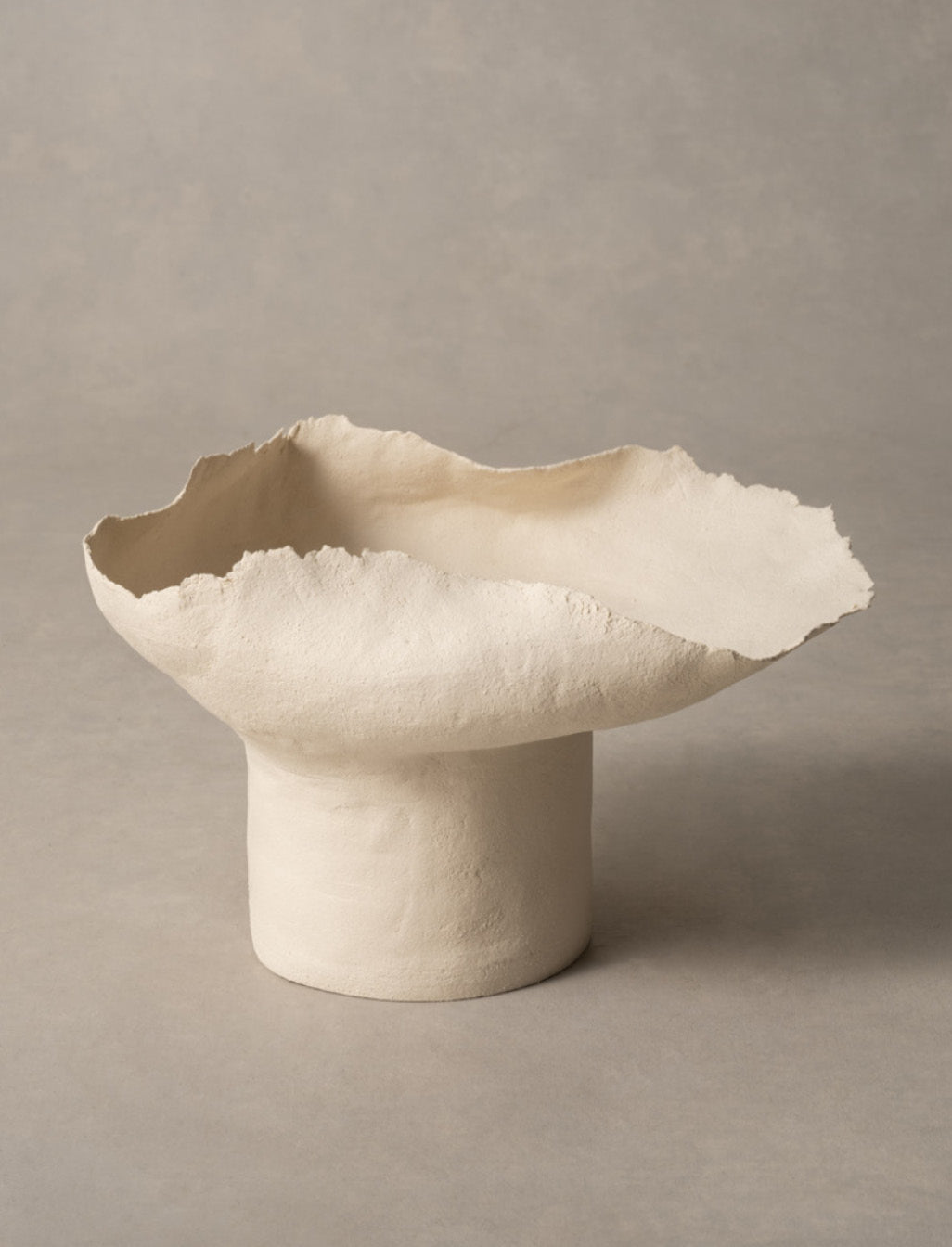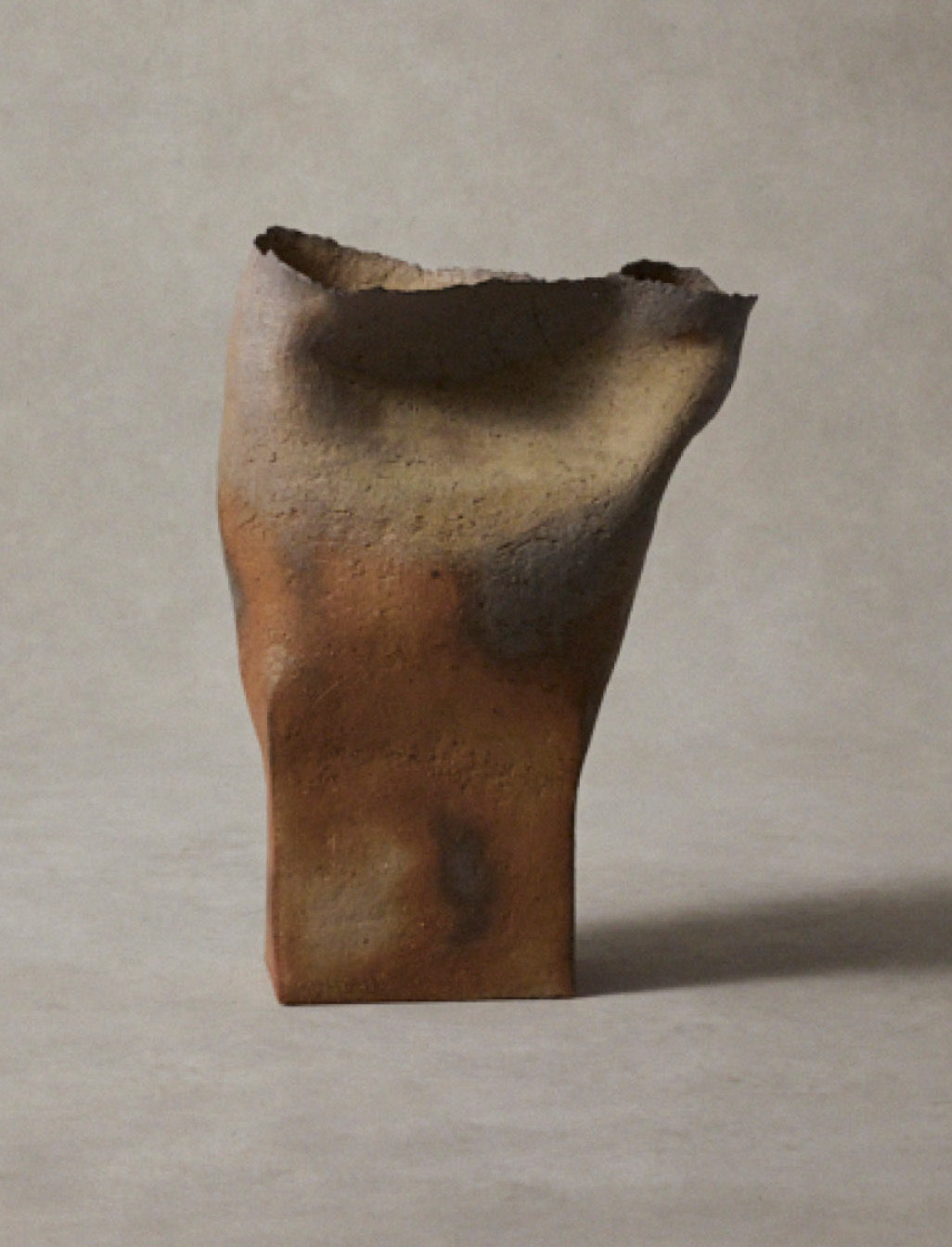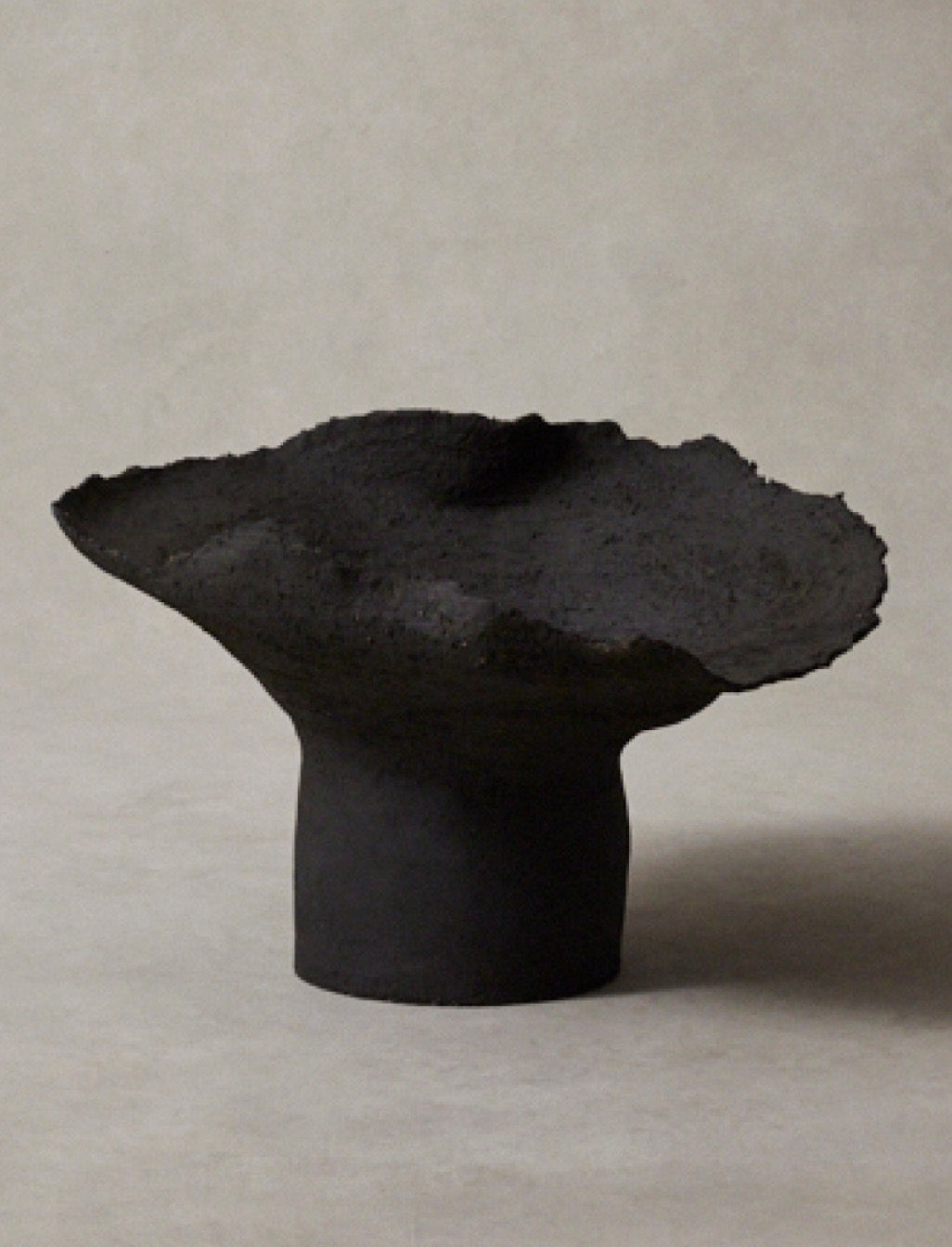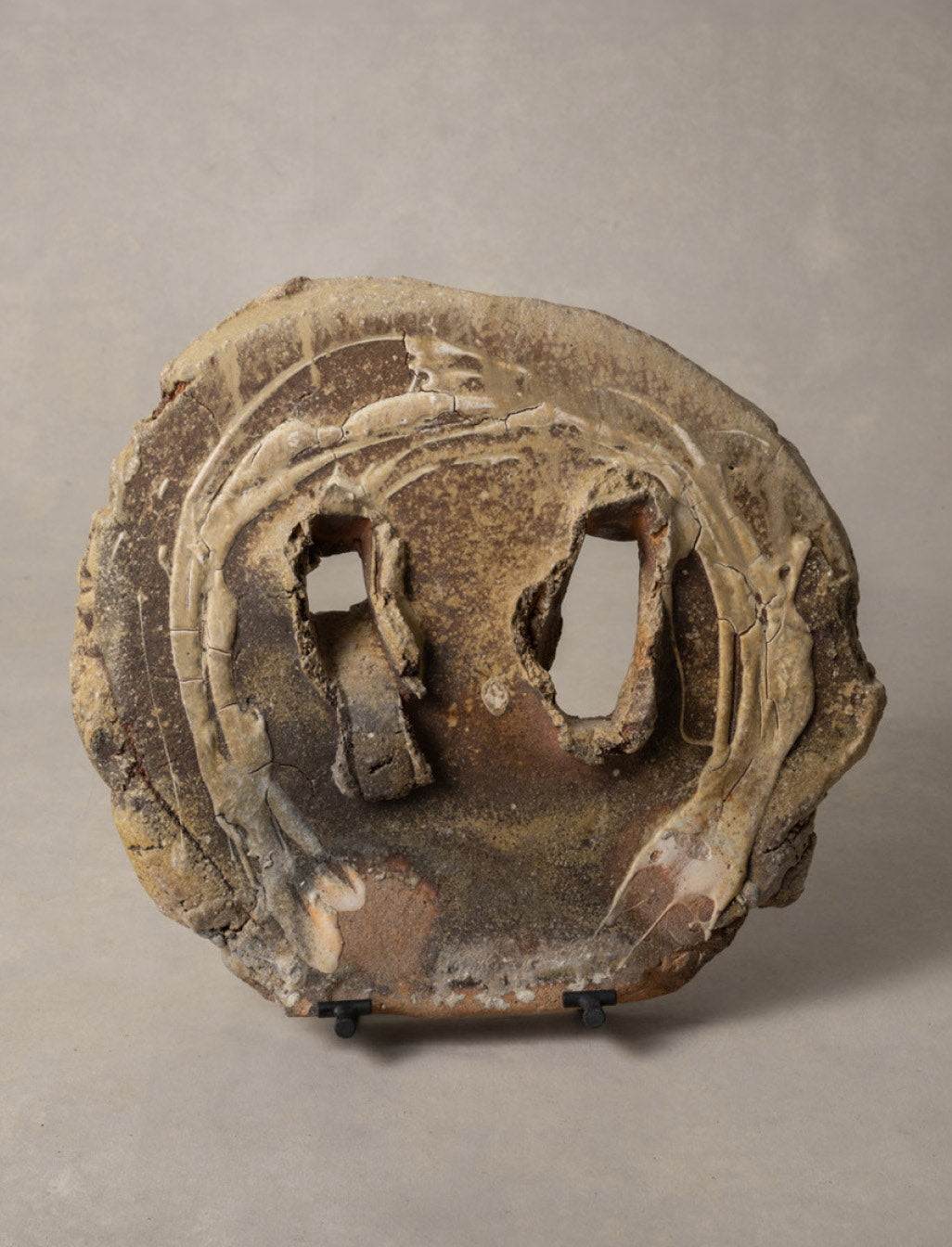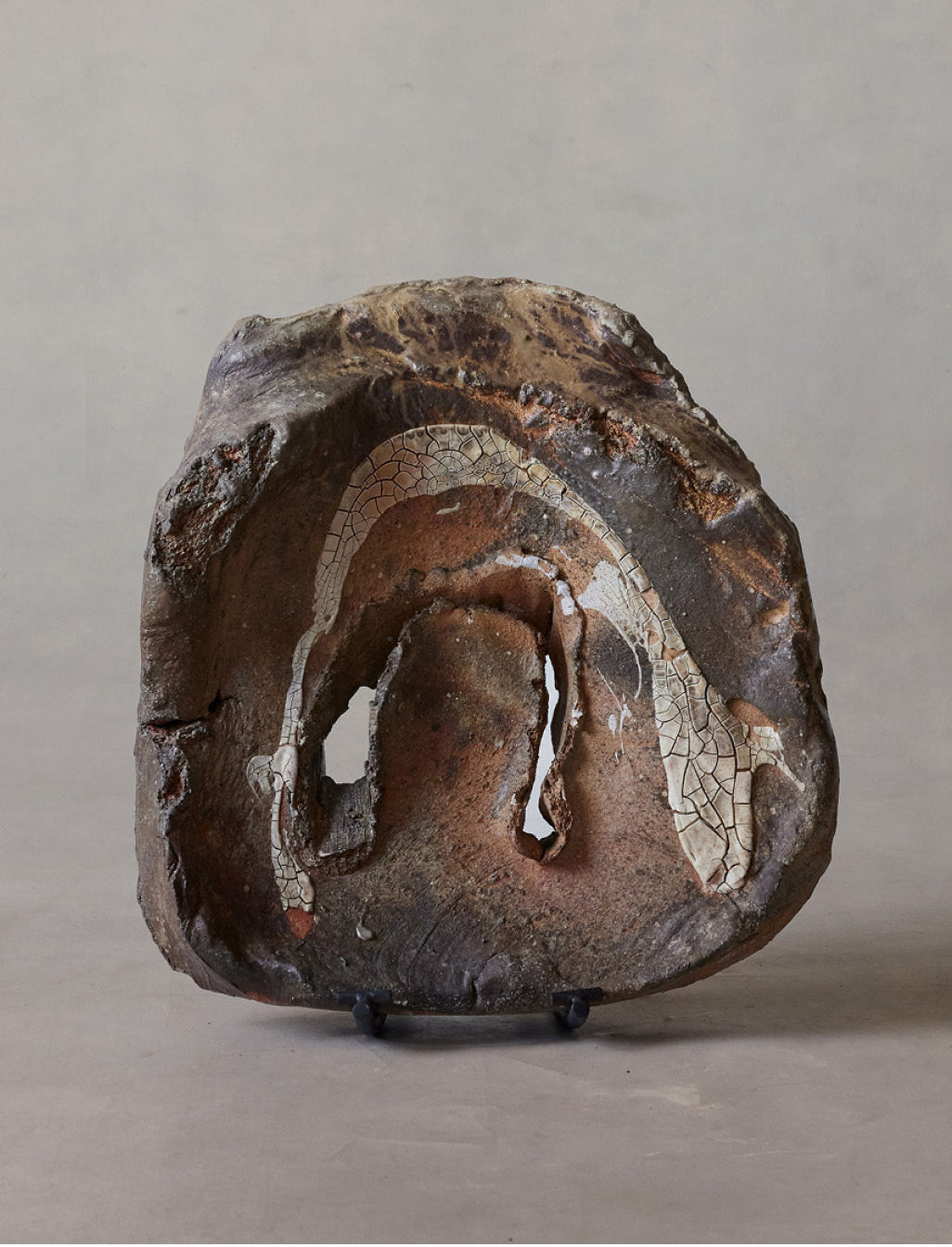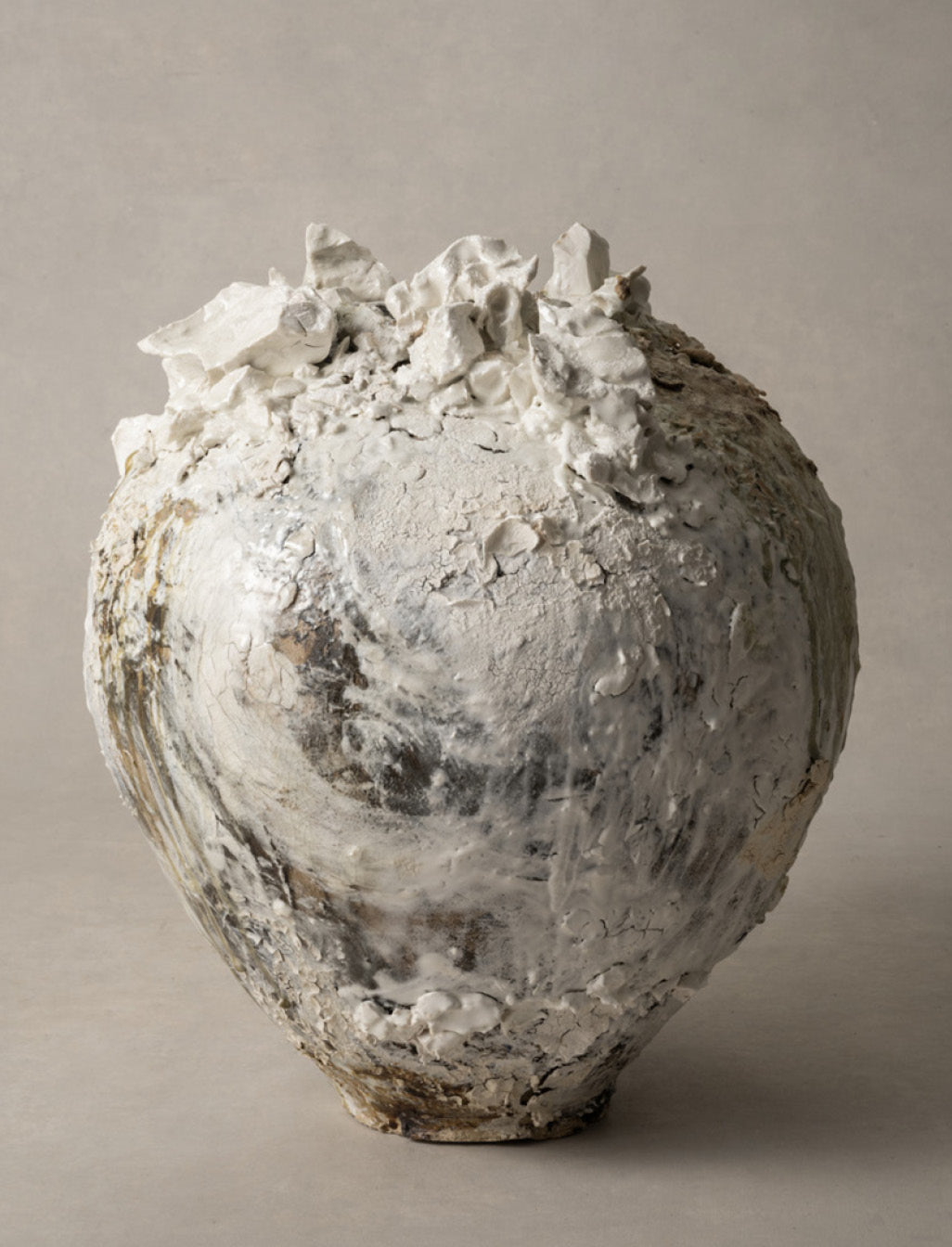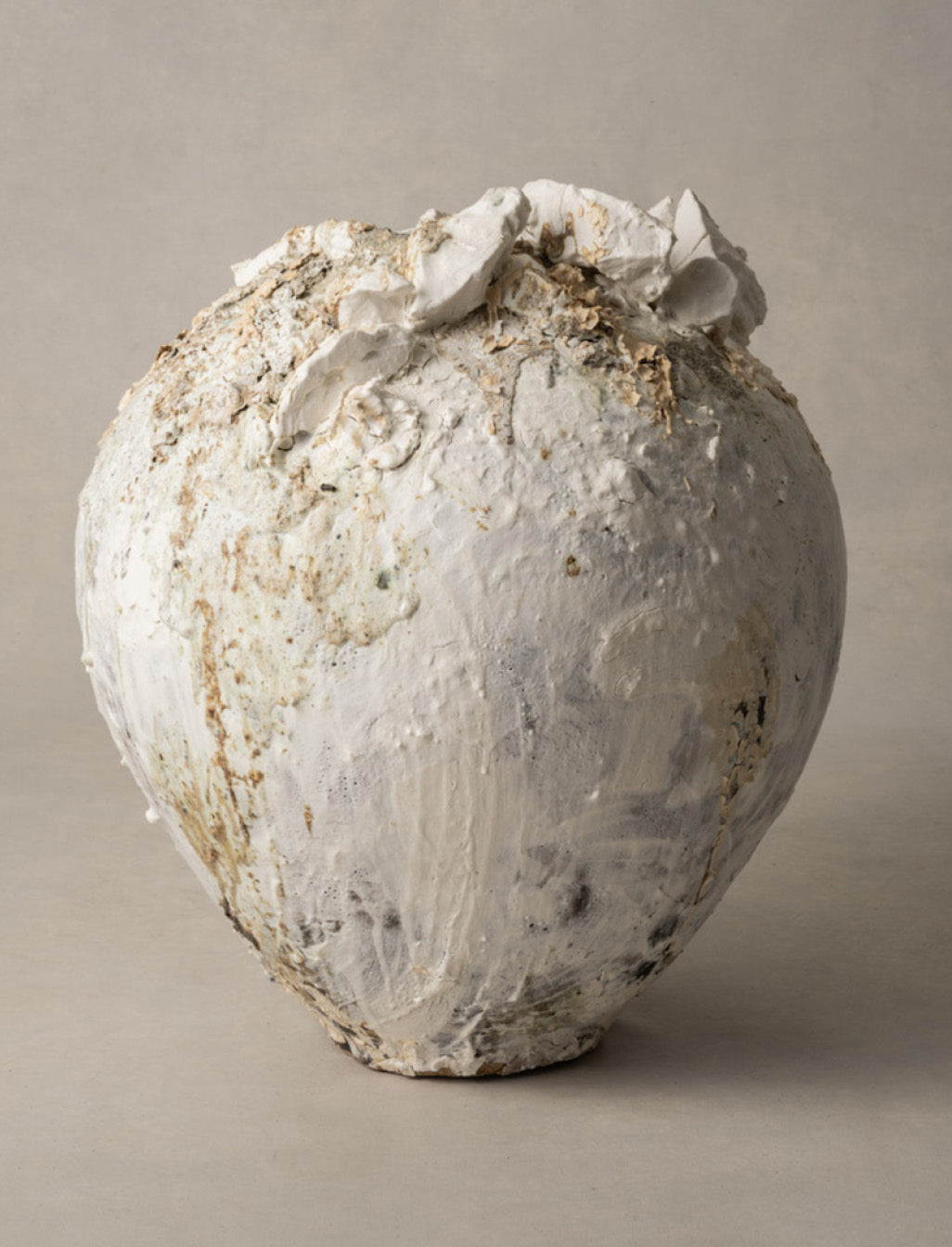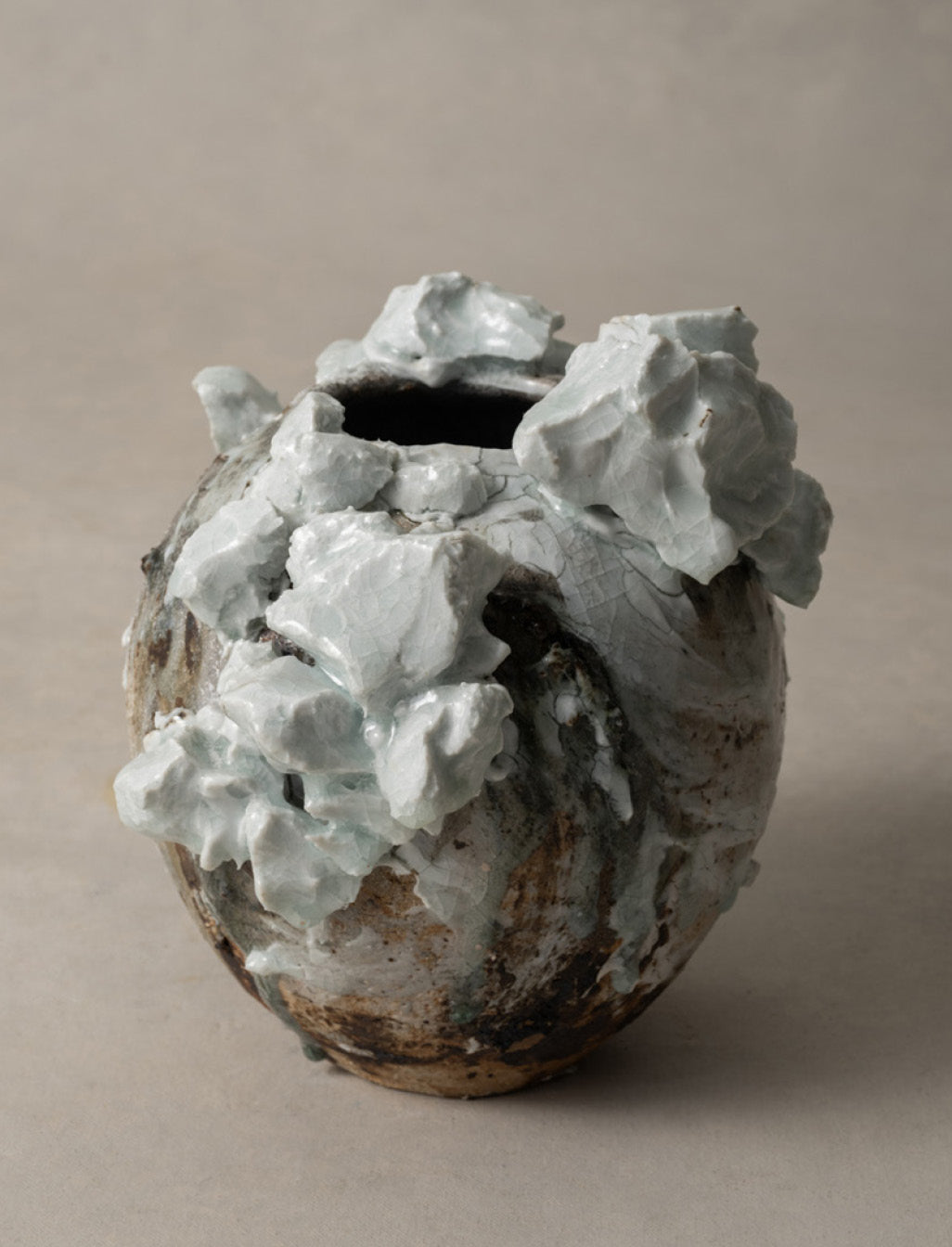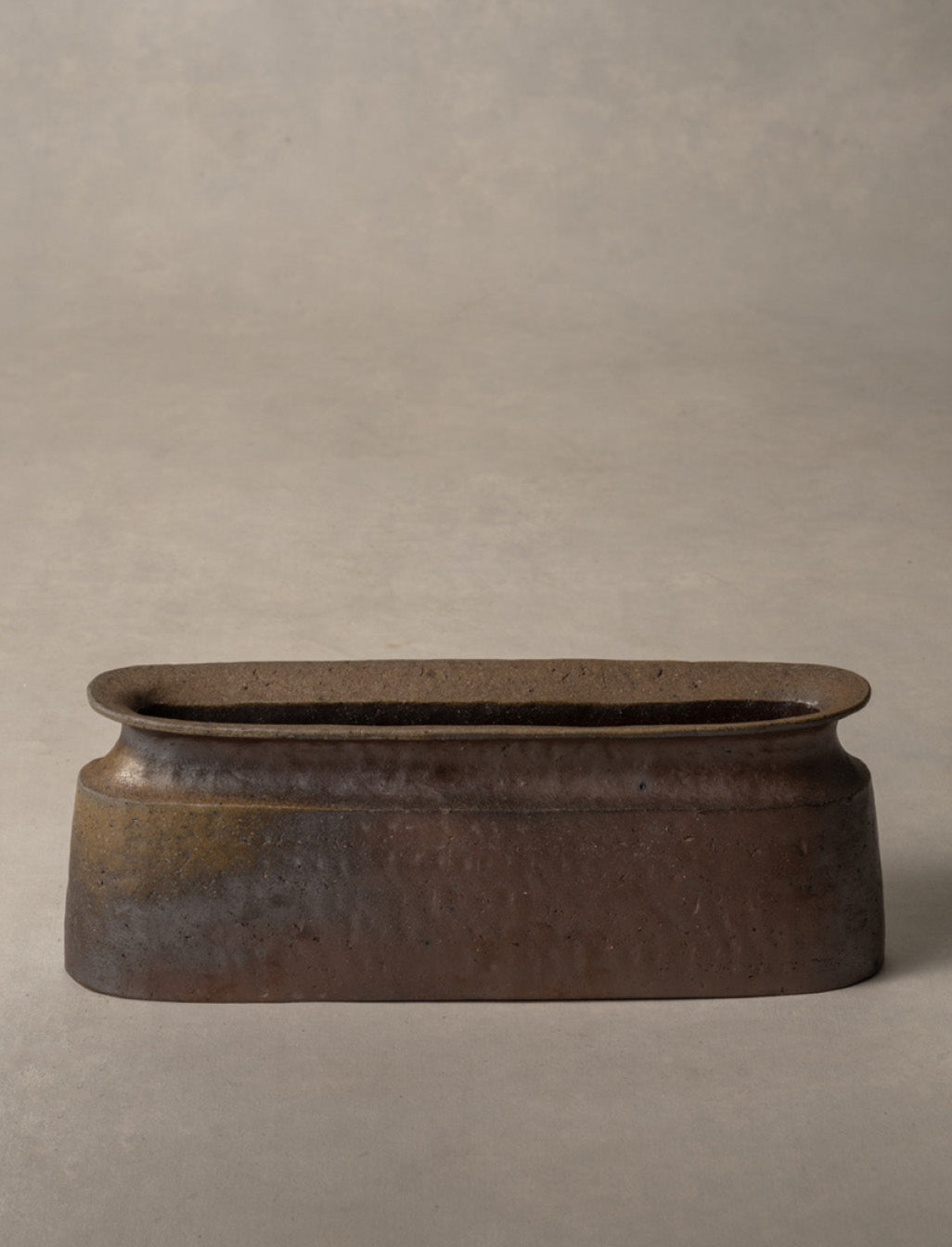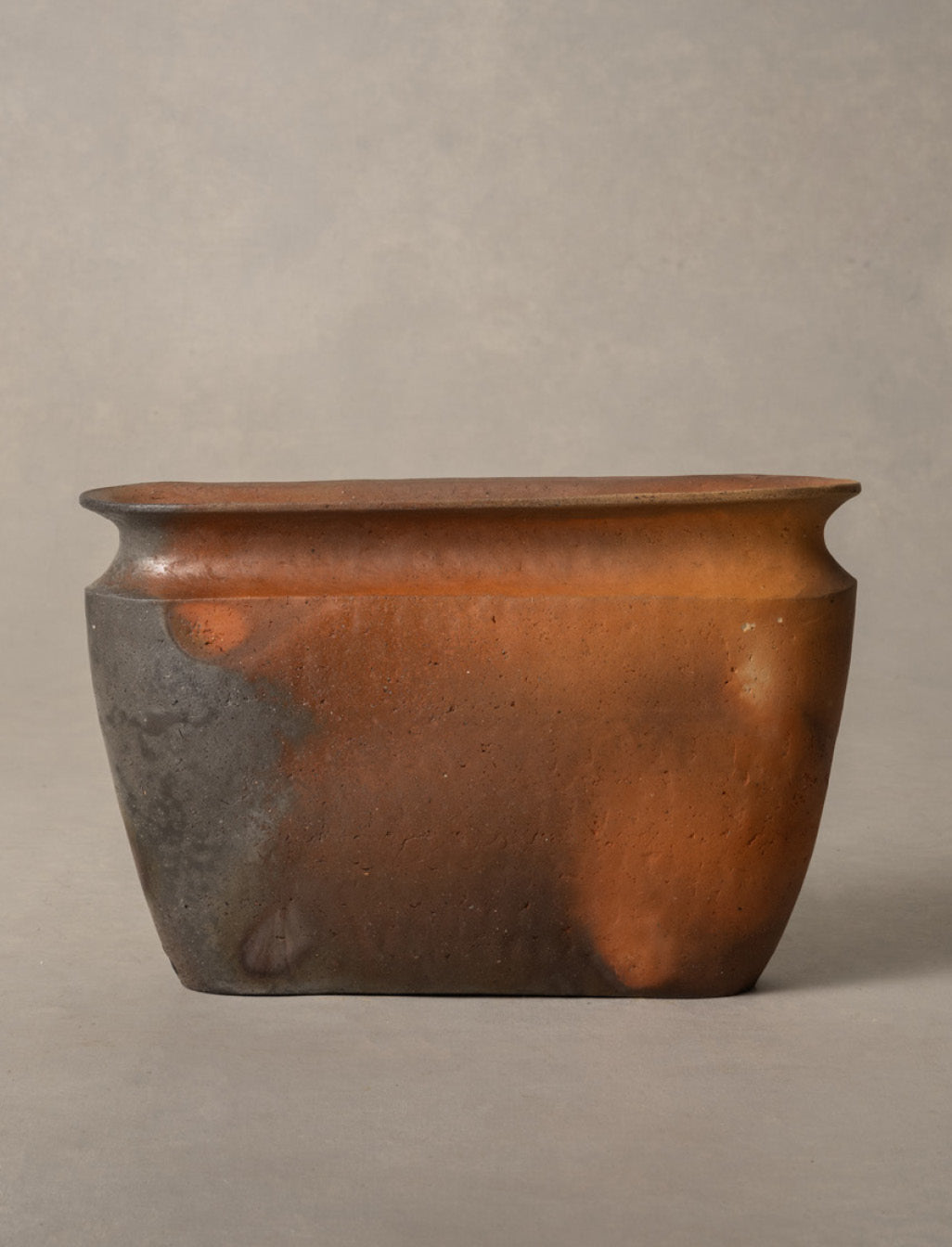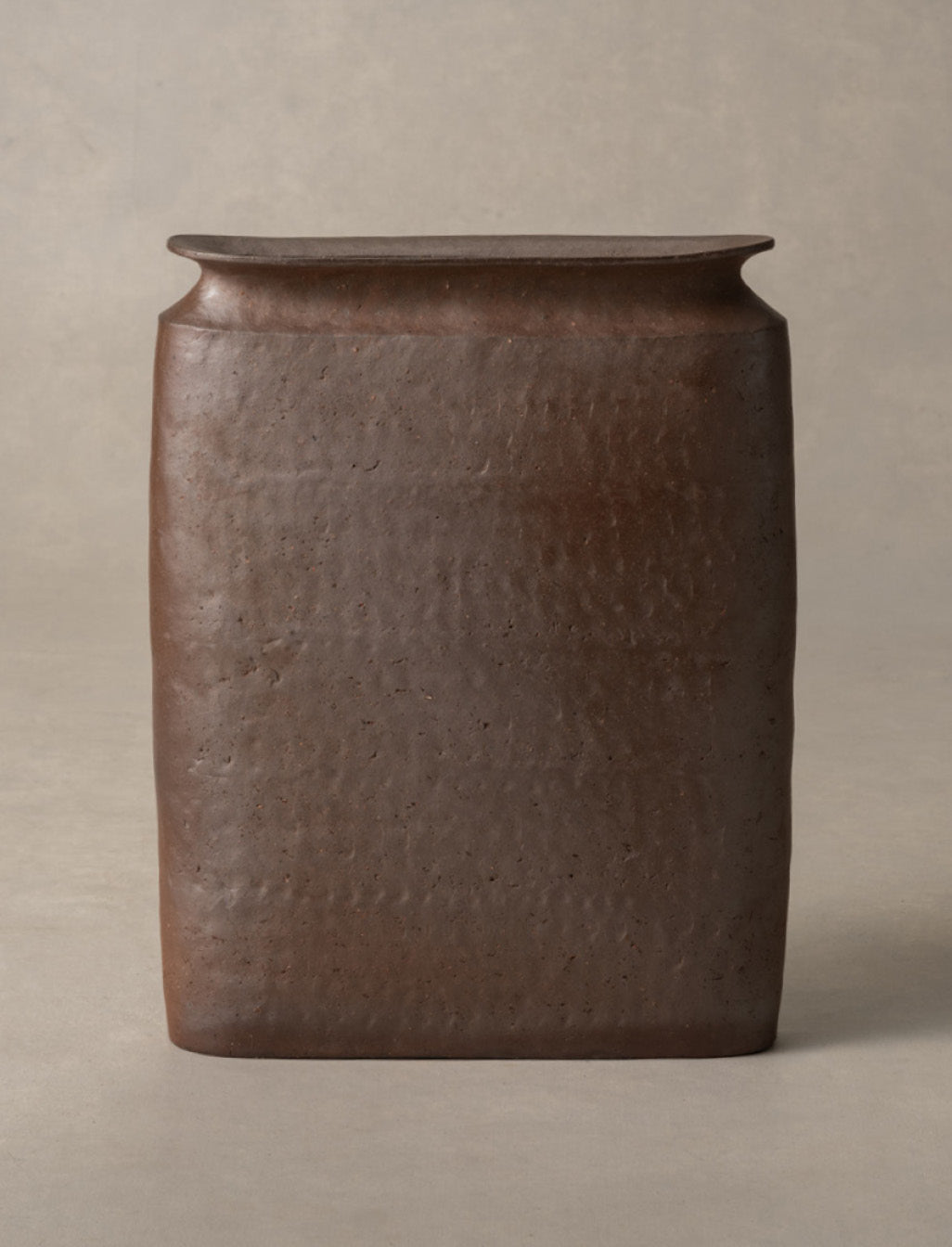Earth and Accident
CURATED BY LUKE SYSON
OPENING RECEPTION
NOV 2, 2023 | 6-8PM
THREE TWO ONE CANAL STREET
NEW YORK, NY 10013
INFO@RWGUILDGALLERYNY.COM
646.693.0279
PRESS RELEASE
Installation
Works
SWITCH PLATE
1990
GLAZED STONEWARE, ANAGAMA WOOD FIRED
21"H X 19"W X 5"D
53.25 H X 48.25 W X 12.75 D CM
PCFM05
KAZAHANA MOON JAR
2023
STONEWARE, PORCELAIN SLIP, PAPER FIBER, WOOD ASH AND WHITE GLAZE
26"H X 21.5"DIA
AHMJ58
THE WHITE CHOCOLATE BISCUIT MOON JAR
2023
STONEWARE, PORCELAIN SLIP, PAPER FIBER, WOOD ASH AND WHITE GLAZE
26"H X 21.5"DIA
AHMJ57
MOON JAR
2021
STONEWARE, PORCELAIN SLIP, PAPER FIBER, WOOD ASH AND WHITE GLAZE
9.25"H X 9.5"W X 8.5"D
Ahmj11
About the Show
Guild Gallery is pleased to present “Earth and Accident,” a group exhibition showcasing historic studio pottery in conversation with works by the next generation of contemporary masters. Curated by Luke Syson, Director and Marlay Curator of the Fitzwilliam Museum at the University of Cambridge, the presentation expands on Guild Gallery’s Frieze Masters 2023 debut, which examined how the British studio pottery movement influenced American and Japanese ceramicists of the 20th century. Broadening its lens to explore 21st century practitioners across the US, Japan, and Europe, “Earth and Accident” marks the first time the gallery is showing historic works alongside contemporary pieces in New York.
The exhibition features examples by some of the most renowned practitioners of 20th-century studio ceramics, including the early American potter George E. Ohr and mid-century masters Peter Voulkos and Toshiko Takaezu, all of whose work crossed the divide between ceramic craft and fine art; the next generation of ceramic artists who expanded on their innovations, including Peter Callas and Eisuke Morimoto; and their emerging successors—including Eisuke’s son Hitoshi Morimoto, Ludmilla Balkis, Casey Zablocki, and Akiko Hirai—who are pushing studio ceramics into revolutionary new territory today.

CASEY ZABLOCKI (B. 1982, USA) LARGE MOON JAR, 2023, WOODFIRED STONEWARE, 26" H X 30"DIA.
As Syson notes in his essay accompanying the exhibition, “By the end of the 19th century, the balanced pottery partnerships between humans and nature that had evolved over centuries had crumbled. The world was flooded with cheap china. The art of clay can explore the investigation and celebration of humans’ oneness with nature, of each person’s individuality, our beauties and our defects, our mistakes, our ugliness, our lives in which the arbitrary, the fortunate, and the inadvertent play crucial parts.”
“These are ideas that have been expressed in the thinking, speaking, writing and, especially, the making—the shaping and firing— of studio potters for more than a century,” Syson continues. “It is a strand of creation that has emanated with passionate clarity from a generous dialogue between potters working in Japan and Korea, those in some of the less metropolitan areas of the United States, and those who have adventurously traveled between them. Once again, the colors of different clays were celebrated, and the things that could happen to pots by happenstance in heat, the incalculable behaviors of ashes, slips, and glazes, all meant that a pot could once again feel as individual as the person making it, as particular as the moment it was made.”
Throughout the exhibition, transformations in the inherent colors and properties of clay elevate these functional items into works of art. The off-center vases of American artist George E. Ohr (1857-1918)—the self-proclaimed “mad potter of Biloxi”—embody this approach. Ohr primarily used red clay that he dug by hand in southern Mississippi, where the slow-drying soil allowed him to make the walls of his pots thin enough to be ruffled and crimped into unglazed vessels with asymmetrical contours.

CERAMIC WORKS BY EISUKE MORIMOTO AND TOSHIKO TAKAEZU.
“THE ART OF CLAY CAN EXPLORE THE INVESTIGATION AND CELEBRATION OF HUMANS’ ONENESS WITH NATURE, OF EACH PERSON’S INDIVIDUALITY, OUR BEAUTIES AND OUR DEFECTS, OUR MISTAKES, OUR UGLINESS, OUR LIVES IN WHICH THE ARBITRARY, THE FORTUNATE, AND THE INADVERTENT PLAY CRUCIAL PARTS.”
– LUKE SYSON
Elsewhere, American artist Toshiko Takaezu (1922-2011), known for her rounded, closed forms, merges the influences of modernism with explorations of Zen Buddhism and the techniques of traditional Japanese pottery. (A major retrospective of her work will tour the Noguchi Museum, the Museum of Fine Arts in Houston, and the Cranbrook Institute of Art, among other institutions, beginning in 2024.) Her fellow countryman Peter Voulkos (1924-2002) channeled abstract-expressionism into ceramic sculpture, reflecting the influence of peers including Robert Rauschenberg and Jasper Johns.
The work by contemporary artists of successive generations in the exhibition is deeply influenced by the work of their predecessors. Peter Callas, in fact, fired Peter Voulkos’s later works in his own Japanese-style anagama kiln and traveled extensively with Voulkos while becoming one of America’s foremost authorities on wood firing. Japanese traditions are also carried forward in the Bizen-ware by Eisuke Morimoto—a method dating back 1,200 years that he has passed down to his son, Hitoshi Morimoto, an acclaimed potter in his own right. In both artists’ work, inimitable coloring created by qualities inherent to the clay are brought out under extreme, enduring heat during firing.

CERAMIC WORKS BY AKIKO HIRAI & LUDMILLA BALKIS.
The same qualities emerge in vastly different form in heavily textured Moon Jars by Akiko Hirai, an emerging artist whose work honors chance and nature in the surface tension she draws between rough and refined, indelibly marked by the movement of her fingers. Ludmilla Balkis’s swirling, gently folded vessels owe a debt not only to Japanese masters, but also to the twisted forms and thin bisque walls of George Ohr’s vases, as well as to her own background in textiles. By contrast, Casey Zablocki’s weighty, earthy, wood-fired pieces reflect the influence of both Voulkos and Callas (with whom he studied), while his application of local slip adds a new dimension all his own.
Though they are all influenced by the techniques of their forebears, each artist featured in “Earth and Accident” found their own, entirely original voice, inflected with a reverence for the expressiveness of texture, tone, and color made possible by clay.

LUDMILLA BALKIS IN HER STUDIO
LUDMILLA BALKIS
B. 1981, FRANCE
Ludmilla Balkis has been defining sumptuous minimalism for decades, first as a fashion designer for houses including Phoebe Philo’s Céline, and now as a ceramicist, manipulating clay like fabric for her swirling, gently folded vessels. Building on her background in fashion and art history, Balkis studied ceramics with Freya Bramble Carter in 2014 in London. Initially she drew inspiration from the distinctive approaches of pioneering ceramicists Lucy Rie, Hans Copper, and Jennifer Lee. Then, after returning to France in 2017, she was introduced to Japanese and Korean approaches to clay. Based in Basque country, daily contact with soil and the area’s raw, natural splendor have become central to her practice, breathing new life into her search for imperfection and unequivocal devotion to minimalism. Balkis has exhibited in galleries and museums across Europe, including Paris, Biarritz, and Berlin.

PETER CALLAS IN HIS STUDIO
PETER CALLAS
B. 1951, USA
One of the foremost American sculptors working in clay today, Peter Callas forges large-scale, abstractexpressionist sculptures using a traditional wood-fired anagama kiln. After an extensive period of studying anagama kilns in Japan early in his career, he built one of his own in America, the first ever constructed in the country. Callas’s inventive creations possess an ancient quality, seemingly battle-worn and scarred, as if they live and breathe, whisper and sigh—but within them pulses an undercurrent of tension, energy, and passion, reflecting the artist’s inner life and aesthetic vision. Callas has exhibited work in Australia, France, Germany, Brazil, China, Korea, Japan, Norway, and throughout the United States. In 2017, he was elected to the International Academy of Ceramics, and in 2018, he received the prestigious Pollock-Krasner Foundation Grant. His work is found in museum collections in America and around the world.

AKIKO HIRAI IN HER STUDIO
AKIKO HIRAI
B. 1970, JAPAN
Born in Shizuoka, Japan, Akiko Hirai evinces the unstable and unpredictable nature of clay and fire in the imperfections of her signature heavily textured vessels. Made by hand on a wheel in London, Hirai’s work reflects Japanese tradition, honoring chance and nature through the formation of clay and ash, the surface tension between rough and refined she draws with her fingers, and the marks gathered in the firing process. Hirai studied ceramics at the University of Westminster and Central Saint Martins. She was shortlisted for the LOEWE craft prize in 2019, and her work can be found in the collections of Germany’s Keramikmuseum Westerwald and England’s Victoria and Albert Museum.

EISUKE MORIMOTO IN HIS STUDIO
EISUKE MORIMOTO
B. 1941, JAPAN
The Japanese ceramicist Eisuke Morimoto is a modern master of Bizen-yaki, the oldest living form of pottery in Japan and one of the six forms adapted from Korea’s stoneware tradition during the Heian period roughly 1,200 years ago. Morimoto still uses the four-chamber Nobori-kama wood-fired kiln he built a half century ago, as does his son Hitoshi Morimoto, to whom he has passed on this ancient tradition, and an internationally acclaimed sculptor in his own right. The soil used to form Morimoto’s clay is mined from the fields of Inbe, near his home in Bizen. To achieve his signature Bizen-yaki finishes, Morimoto uses no glazes or paints of any kind; instead, the hues of his work are born from preexisting qualities found in his clay, brought out under extreme heat during the firing process.

HITOSHI MORIMOTO IN HIS STUDIO
HITOSHI MORIMOTO
B. 1976, JAPAN
The Japanese ceramicist Hitoshi Morimoto is an emerging master of Bizen-yaki, ushering the oldest living form of pottery in Japan into a revolutionary new era. Working with local soil mined from the fields of Inbe and firing his pieces in a 50-year-old kiln hand-built by his father, the celebrated Bizen artist Eisuke Morimoto, Hitoshi forges works of unglazed clay and ash marked by their intricate textures, bold colors, and expressive finishes.

GEORGE E. OHR, THE SELF-PROCLAIMED “MAD POTTER OF BILOXI”
GEORGE E. OHR
1857-1918, USA
The self-proclaimed “Mad Potter of Biloxi,” George Ohr transformed the traditional folk aesthetic in pottery into a pioneering form all his own. The self-taught American ceramicist’s vessels are technical tours de force, unrivaled in the thinness of their bodies, the control with which they are shaped—and, crucially, the ways they are misshapen. Ohr threw technically perfect vessels, then folded and twisted them into unique, unconventional forms. Though he claimed to have made more than 20,000 ceramic pieces, his work remained largely unknown at the time of his death in 1918. For decades, his pots sat in a garage in Mississippi, behind a gas station owned by his sons, before being unearthed and recognized for their preeminent, groundbreaking importance: Ohr’s work is now seen as a harbinger of the American abstract sculpture and pottery movement, a significant chapter in the history of American ceramics that rose to prominence in the mid-20th century.

TOSHIKO TAKAEZU IN HER STUDIO
TOSHIKO TAKAEZU
(1922–2011, USA)
Toshiko Takaezu was an American ceramic artist, painter, sculptor, and educator who is known for her rounded, closed forms that helped push ceramics, long regarded merely as functional vessels, into the realm of fine art. Born in Hawaii to Japanese parents, Takaezu studied painting at the University of Hawaii and ceramics at the Cranbrook Academy of Art, where the influence of modernism took hold in her work. She traveled to Japan in 1955, exploring Zen Buddhism, tea ceremony, and the techniques of traditional Japanese pottery, all of which manifested in her pieces. Known as a profoundly influential teacher and mentor, Takaezu indelibly shaped generations of younger artists at the Cleveland Institute of Art and Princeton University. Her work is found in the collections of the Metropolitan Museum of Art in New York, the Museum of Fine Arts in Boston, the Los Angeles County Museum of Art, and the Philadelphia Museum of Art, among dozens of other museums.

PETER VOULKOS IN HIS STUDIO
PETER VOULKOS
1924-2002, USA
A legendary figure in the history of American ceramics, Peter Voulkos was a Greek-American artist renowned for his abstract expressionist sculptures, which crossed the traditional divide between ceramic crafts and fine art, helping to revolutionize the form. He established the ceramics departments at the Los Angeles County Art Institute and at UC Berkeley, where he became known for the live sculpting sessions he held in front of his students, demonstrating his intense, even unforgiving approach to working with raw material while simultaneously showcasing his mastery of craft. His work is found in more than 100 museum collections around the world, including the Metropolitan Museum of Art and the Museum of Modern Art in New York; the Smithsonian in Washington, D.C.; the Philadelphia Museum of Art; the Stedelijk Museums in Amsterdam and Eindhoven; and the Tokyo Folk Art Museum and the Kyoto National Museum of Modern Art in Japan.

CASEY ZABLOCKI IN HIS STUDIO
CASEY ZABLOCKI
B. 1982, USA
Portraits of time and deterioration, Casey Zablocki’s functional sculptures are born from consistent experimentation with clay recipes and wood ash combinations. Inspired by the convergence of five mountain ranges at his home in Missoula, Montana, Zablocki’s magnificent surfaces bloom from extreme and prolonged heat exposure within the large anagama kilns in which the works are fired - often for up to twelve days at a time. Zablocki has spent decades immersed in creative practice: he grew up in a family of makers in the Upper Peninsula of Michigan, studied at Montana State University, and apprenticed for world-renowned sculptors Peter Callas and Hun Chung Lee.

